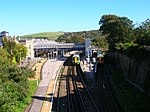Southover Grange
Country houses in East SussexEast Sussex County CouncilGardens in East SussexLewes

Southover Grange in Lewes, Sussex is a house of historical significance and is Grade II* listed on the English Heritage Register. It was built in 1572 by William Newton and owned by this family for the next three hundred years. After this it was the residence of many notable people until it was bought by the local Council in about 1945. Today it is owned by the East Sussex County Council. It now houses the Lewes Register Office which provides Marriage Ceremony Packages, civil partnerships and citizenship ceremonies. The gardens host events from local theatre to beer an gin festivals.
Excerpt from the Wikipedia article Southover Grange (License: CC BY-SA 3.0, Authors, Images).Southover Grange
Southover Road,
Geographical coordinates (GPS) Address External links Nearby Places Show on map
Geographical coordinates (GPS)
| Latitude | Longitude |
|---|---|
| N 50.8707 ° | E 0.0071 ° |
Address
Southover Grange
Southover Road
BN7 1TP , Southover
England, United Kingdom
Open on Google Maps











